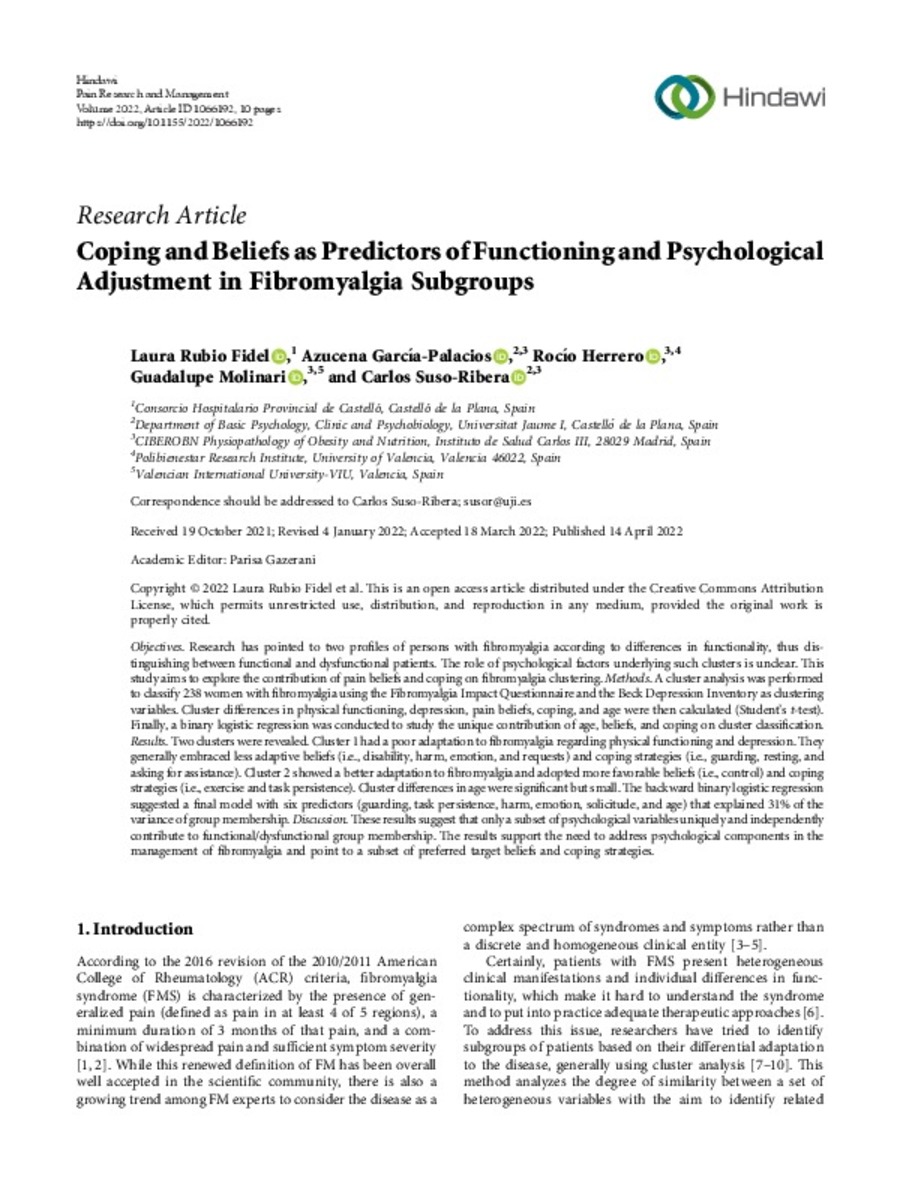Mostrar el registro sencillo del ítem
Coping and beliefs as predictors of functioning and psychological adjustment in fibromyalgia subgroups
| dc.contributor.author | Rubio Fidel, Laura | |
| dc.contributor.author | García-Palacios, Azucena | |
| dc.contributor.author | Herrero, Rocío | |
| dc.contributor.author | Molinari, Guadalupe | |
| dc.contributor.author | Suso-Ribera, Carlos | |
| dc.date.accessioned | 2022-10-18T09:04:15Z | |
| dc.date.available | 2022-10-18T09:04:15Z | |
| dc.date.issued | 2022-04-14 | |
| dc.identifier.citation | Laura Rubio Fidel, Azucena García-Palacios, Rocío Herrero, Guadalupe Molinari, Carlos Suso-Ribera, "Coping and Beliefs as Predictors of Functioning and Psychological Adjustment in Fibromyalgia Subgroups", Pain Research and Management, vol. 2022, Article ID 1066192, 10 pages, 2022. | ca_CA |
| dc.identifier.issn | 1203-6765 | |
| dc.identifier.issn | 1918-1523 | |
| dc.identifier.uri | http://hdl.handle.net/10234/200436 | |
| dc.description.abstract | -Objectives. Research has pointed to two profiles of persons with fibromyalgia according to differences in functionality, thus distinguishing between functional and dysfunctional patients. The role of psychological factors underlying such clusters is unclear. This study aims to explore the contribution of pain beliefs and coping on fibromyalgia clustering. -Methods. A cluster analysis was performed to classify 238 women with fibromyalgia using the Fibromyalgia Impact Questionnaire and the Beck Depression Inventory as clustering variables. Cluster differences in physical functioning, depression, pain beliefs, coping, and age were then calculated (Student’s t-test). Finally, a binary logistic regression was conducted to study the unique contribution of age, beliefs, and coping on cluster classification. -Results. Two clusters were revealed. Cluster 1 had a poor adaptation to fibromyalgia regarding physical functioning and depression. They generally embraced less adaptive beliefs (i.e., disability, harm, emotion, and requests) and coping strategies (i.e., guarding, resting, and asking for assistance). Cluster 2 showed a better adaptation to fibromyalgia and adopted more favorable beliefs (i.e., control) and coping strategies (i.e., exercise and task persistence). Cluster differences in age were significant but small. The backward binary logistic regression suggested a final model with six predictors (guarding, task persistence, harm, emotion, solicitude, and age) that explained 31% of the variance of group membership. -Discussion. These results suggest that only a subset of psychological variables uniquely and independently contribute to functional/dysfunctional group membership. The results support the need to address psychological components in the management of fibromyalgia and point to a subset of preferred target beliefs and coping strategies. | ca_CA |
| dc.format.extent | 10 p. | ca_CA |
| dc.format.mimetype | application/pdf | ca_CA |
| dc.language.iso | eng | ca_CA |
| dc.publisher | Hindawi | ca_CA |
| dc.relation | Redes de Excelencia ISIC | ca_CA |
| dc.relation.isPartOf | Pain Research and Management, Volume 2022 | ca_CA |
| dc.rights.uri | http://creativecommons.org/licenses/by/4.0/ | ca_CA |
| dc.subject | fibromyalgia | ca_CA |
| dc.subject | psychological factors | ca_CA |
| dc.title | Coping and beliefs as predictors of functioning and psychological adjustment in fibromyalgia subgroups | ca_CA |
| dc.type | info:eu-repo/semantics/article | ca_CA |
| dc.identifier.doi | https://doi.org/10.1155/2022/1066192 | |
| dc.rights.accessRights | info:eu-repo/semantics/openAccess | ca_CA |
| dc.type.version | info:eu-repo/semantics/publishedVersion | ca_CA |
| project.funder.name | Generalitat Valenciana | ca_CA |
| oaire.awardNumber | ISIC/2012/012 | ca_CA |
Ficheros en el ítem
Este ítem aparece en la(s) siguiente(s) colección(ones)
-
PSB_Articles [1303]
Articles de publicacions periòdiques








